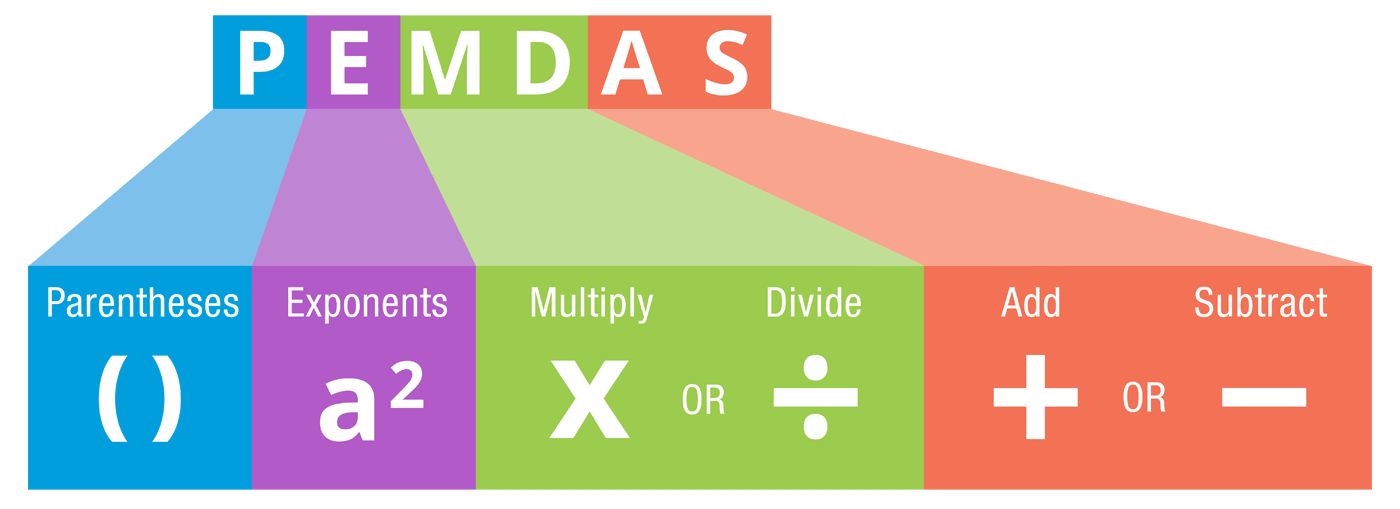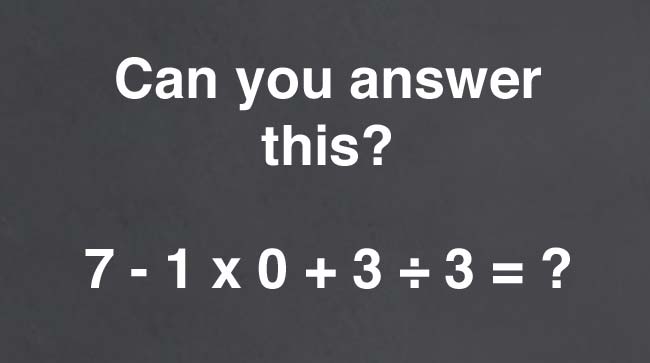PEMDAS Explained - How Does PEMDAS Work?
PEMDAS is a mnemonic acronym for the order of operations in math: parentheses; exponents; multiply or divide; add or subtract. When there are several operations in a single expression, it's important to calculate them in the proper order (parenthesis first, exponents second...) to get the correct outcome.

Like anything in life, math is a matter of priorities. In the 'real world', if we get our sequencing wrong, then we end up putting the kids on the school bus in their pajamas, getting ourselves dressed from the unwashed laundry hamper, and eating spoonfuls of dry coffee grounds before drinking scalding hot water. Well, we all have our off days.
The point is that the order of things clearly matters. It's the same with numbers; PEMDAS keeps you on the right track when calculating an expression that has more than one operation.
The problem
The following sum has two numbers (1, 2), and a single operation (addition + ).
1 + 2 = ?
No PEMDAS needed here, right? The answer is obviously 3.
OK. How about this next one? It has three numbers (1, 2, 3) but this time, it has two operators (addition + and multiplication x ).
1 + 2 x 3 = ?
Suddenly we need to have a little lie down (and a few spoonfuls of coffee grounds). Because there are two operators, we need to know which one comes first, and it's not always as simple as just calculating from left to right.
So... do you add the 1 and 2 together first, so that the sum becomes 3 x 3? Or do you multiply 2 by 3 first, to make the sum into 1+ 6? One version produces the answer 7, whilst working in a different order produces 9. They can't both be right, which is why PEMDAS matters.
(The answer, if it's bugging you, is to multiply first, because the M for multiplication comes before the A for addition in PEMDAS. So the 2 x 3 turns into 6, and the sum becomes 1 + 6 = 7).
PEMDAS - the acronym
We're going to get into exactly how to use PEMDAS in a minute, but first, let's think about the acronym itself. It goes by different names, but the important thing is that the order always remains the same (it's just that some letters change because those operations may be called something else in another country).
The US favourite:
PEMDAS
- Parenthesis
- Exponents
- Multiplication
- Division
- Addition
- Subtraction
You may also hear it being referred to as one of these:
- PIDMAS: Parenthesis, Index, Divide or Multiply, Add or Subtract
- BODMAS (UK): Brackets, Order, Divide or Multiply, Add or Subtract
- BIDMAS: Brackets, Index, Divide or Multiply, Add or Subtract
- BEMDAS (Canada): Brackets, Exponent, Multiply or Divide, Add or Subtract
Now, if only there was a mnemonic to help us remember which name to use for PEMDAS in which location...
How to remember PEMDAS
PEMDAS is pretty catchy as a word in itself, but if you have a particular fondness for memorising abbreviations, then you could use one of these sentences to help...
- Please excuse my dear aunt Sally
- Pretend every man dates a seahorse
- Poached eggs make December a sensation
- Provoked elves maim dangerous alligators severely
- Parrots eat my donuts at solstice
Personally, we're going with the parrots.
Reacquainting ourselves with PEMDAS
Three-quarters of folk, according to a little test run by Dr. Peter Price of the Classroom Professor website, make incorrect calculations because they don't follow the correct order of operations. He posted a brainteaser on social media in 2012, asking people to give the answer to the following sum:

Over 6000 people responded, and only 26% of them got the correct answer, which is... 8.
How did you fare? Don't worry if you got it wrong; you're in good company! Just check out our comprehensive guide to using PEMDAS below.
How to use PEMDAS, step by step
Have you noticed how we've been breaking up the P E MD AS sequence in this article? That's because you have to mentally group some of the operations as equal partners in crime, rather than one always coming before the other.
It's like Thelma and Louise, Bonnie and Clyde, or Ben & Jerry's. These partnerships share status and neither ranks above the other; even though we have to say one name first, it doesn't mean that Thelma is always first in line for pudding, shoving Louise rudely behind her*. The same goes for the multiply/divide and add/subtract pairs in PEMDAS.
So, here's the correct order of operations in math: first, work out anything within the parentheses; then work out the exponents; next, do any multiplication or division (these two are partners in status, so you simply prioritize them left-to-right); and finally, add or subtract (also partners: go left to right).
* There's a pudding shop at the bottom of that deep crevasse, right?
Step 1: Parenthesis
When it comes to PEMDAS, brackets are large and in charge. Don't even think about touching any other numbers until you've calculated what's going on inside the parentheses. And if you're being foxed by a nest of brackets within brackets, work from the inside out, the opposite of cutlery in a fancy schmancy restaurant.
Once you've done the parentheses, or if there are none, you can move onto the next letter of PEMDAS...
Step 2: Exponent (or Index)
Squares, square roots, powers or indices: all of these operations are next in line after the parentheses. Doesn't matter if they are the last item, left-to-right: they are the E in PEMDAS so they rank second.
As with everything in PEMDAS - if there are none, or if they are dealt with, then move onto the next ranking operation...
Step 3: Multiply and Divide
These are partners in crime, remember, so do any multiplication or division as it comes, from left to right.
Step 4: Add and Subtract
Also partners in crime, these guys are happily lining up and waiting patiently for you to calculate them in the order you find them, from left to right.
PEMDAS Examples
 WRONG
WRONG20 ÷ 5 x 2 = 2
 RIGHT
RIGHT20 ÷ 5 x 2 = 8
RULE: Multiplication and division are equally ranking partners in crime, so always calculate them from left to right. In the incorrect version, 5 x 2 was calculated first, making the sum 20 ÷ 10.
 WRONG
WRONG(1+4) × 3 + 2 = 25
 RIGHT
RIGHT(1+4) × 3 + 2 = 17
RULE: Brackets come first, so even though the addition 'A' is towards the end of PEMDAS, the addition operation inside the brackets has to get completed before anything else. Then, it's the multiplication, and finally, the addition that's outside the brackets. In the incorrect version, 3 + 2 (5) has been multiplied by the sum of 1 + 4 (5).
A more complex PEMDAS example
300 - (4 x 2² + 12)
We have to look at the parentheses first, remember. There are three operators inside these brackets, so we use PEMDAS to figure out that we need to tackle the exponent first.
300 - (4 x 4 + 12)
Still working on the parentheses, there's a multiplication that ranks next.
300 - (16 + 12)
Let's finish the parentheses.
300 - 28
And the final operation is the minus.
300 - (4 x 2² + 12) = 272
PEMDAS Quiz
Think you know your PEMDAS from your elbow? Try our quiz to see if you've got it nailed! There's no prize, other than the bragging rights of being top of the class!
